General, Sir John Monash, Personal Files Book 22, 2 January - 1 February 1919- Part 5
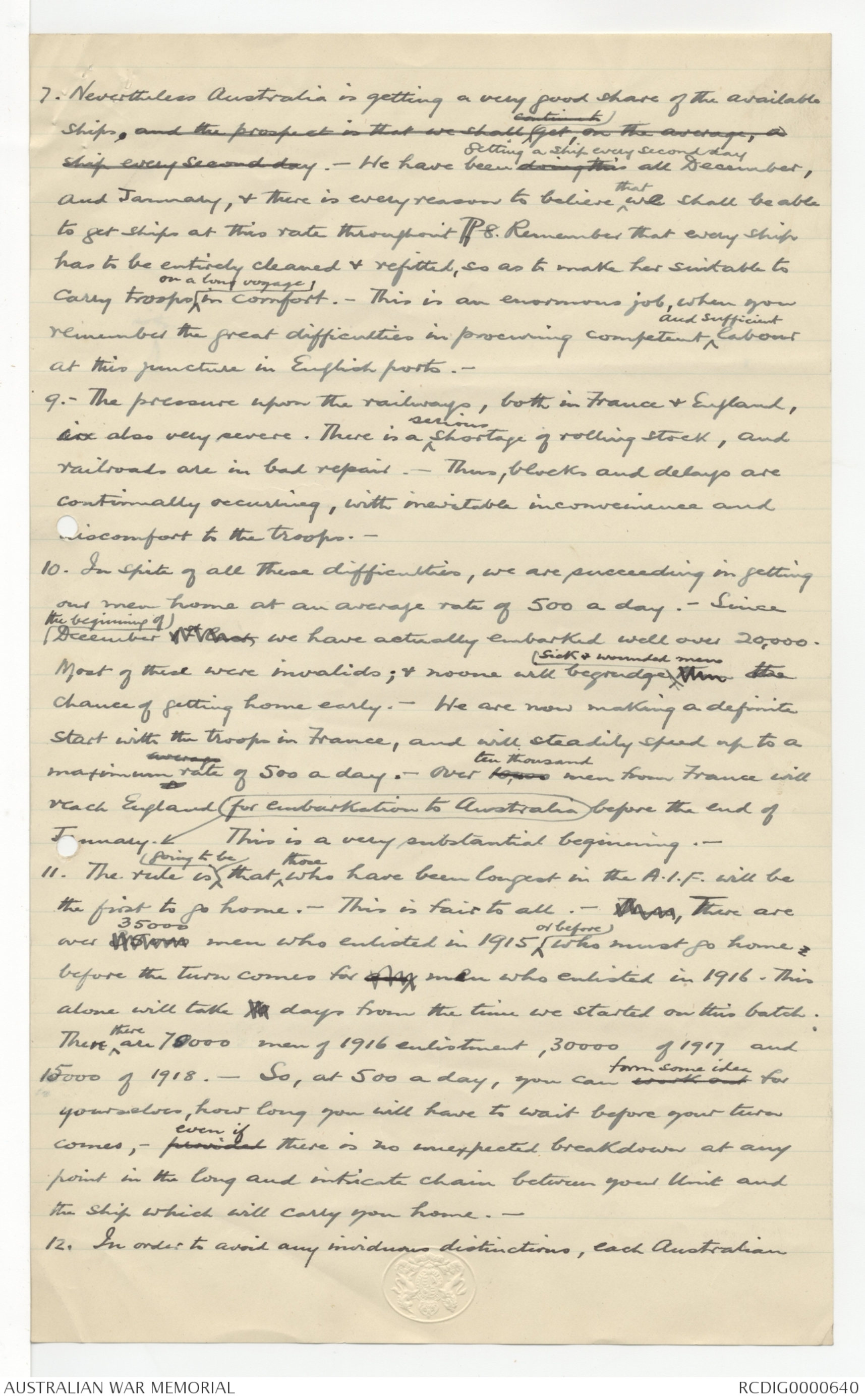
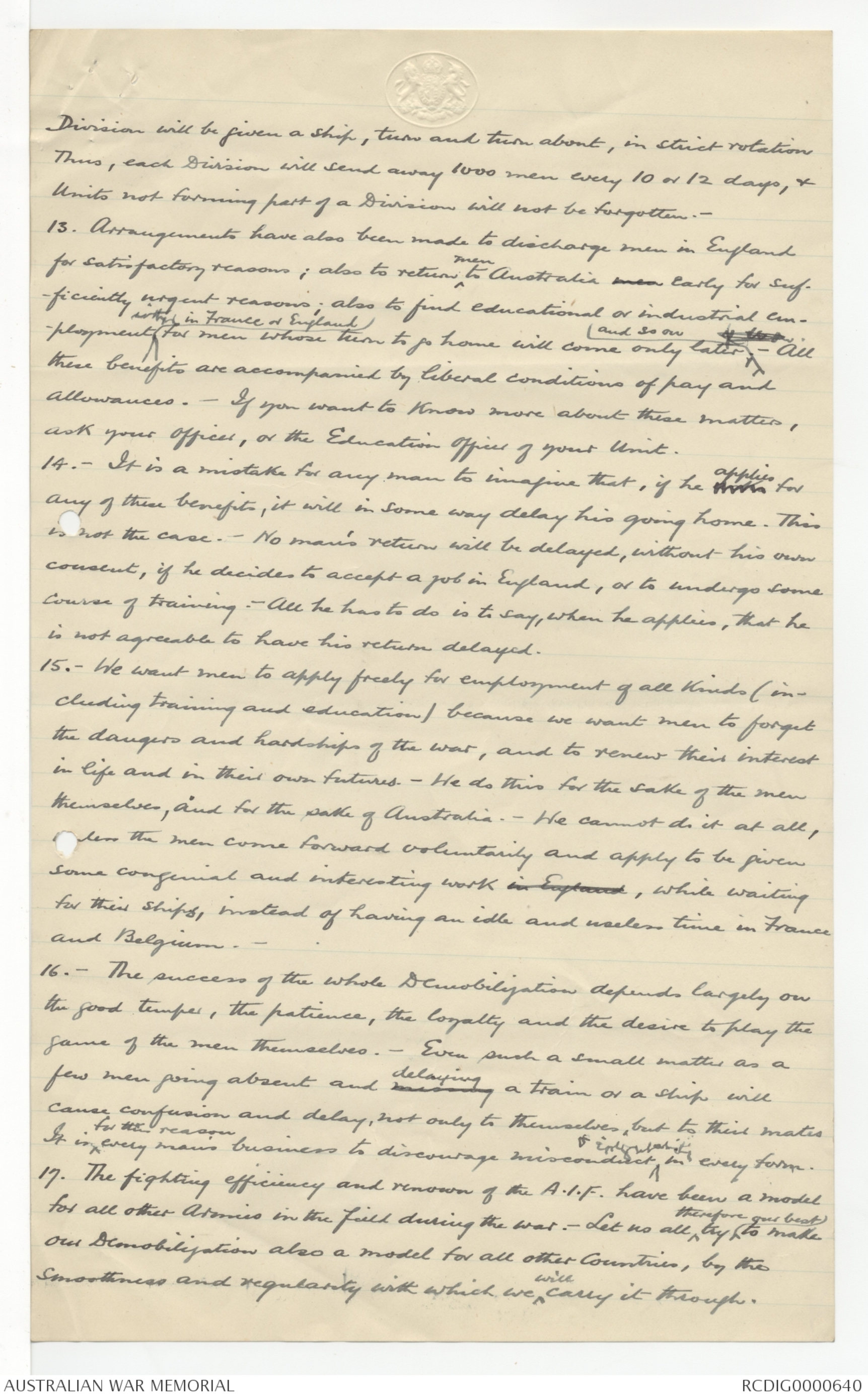
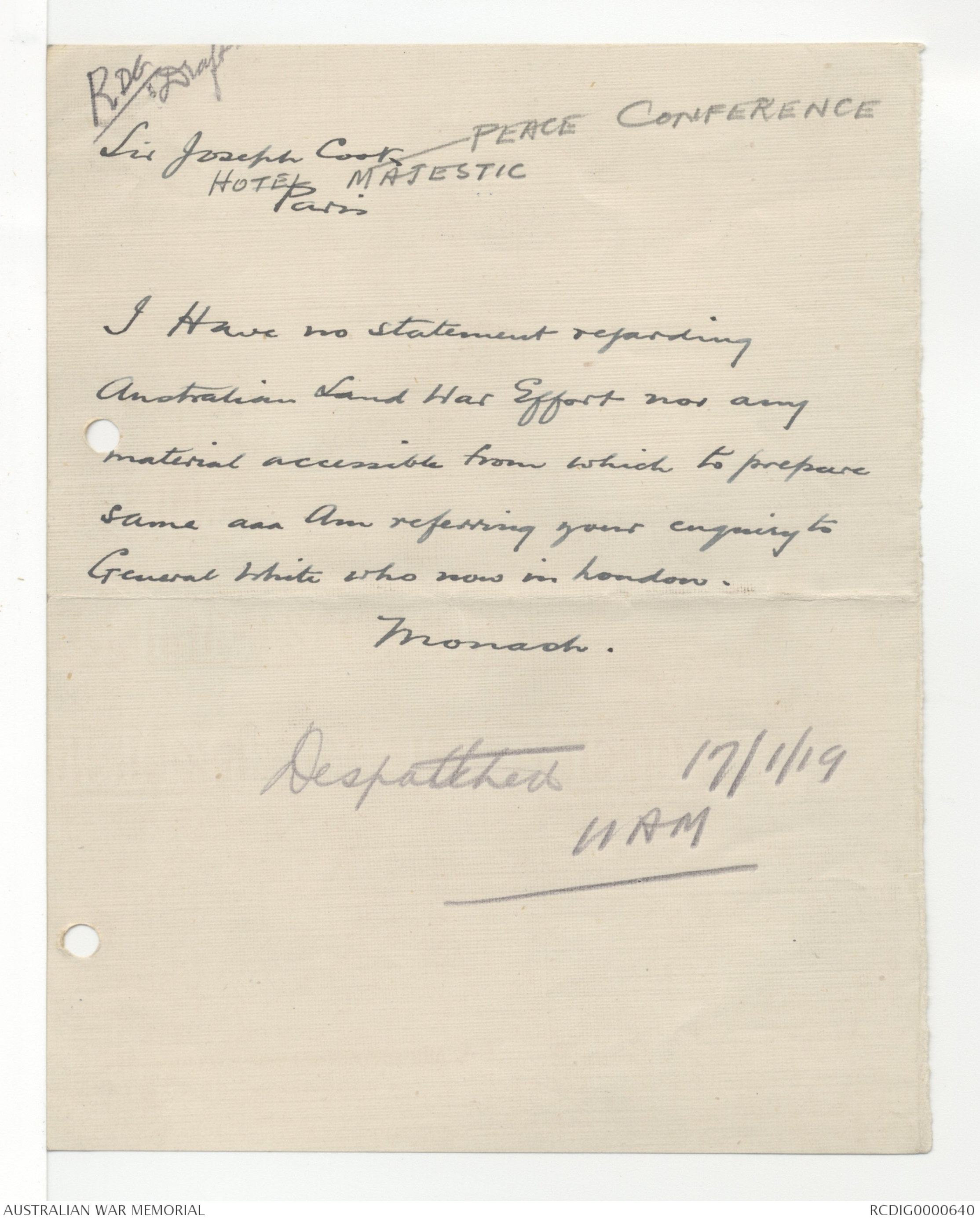
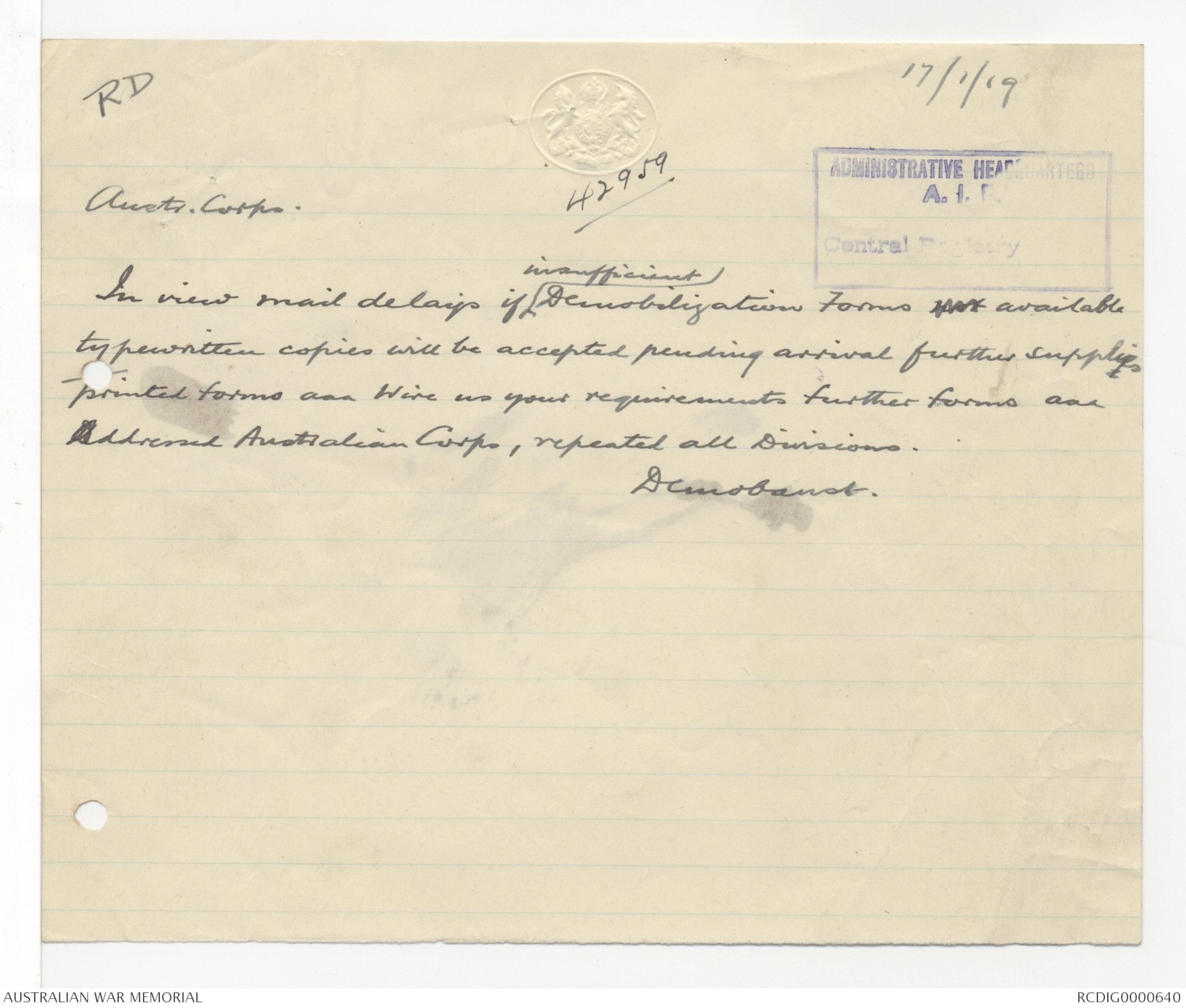
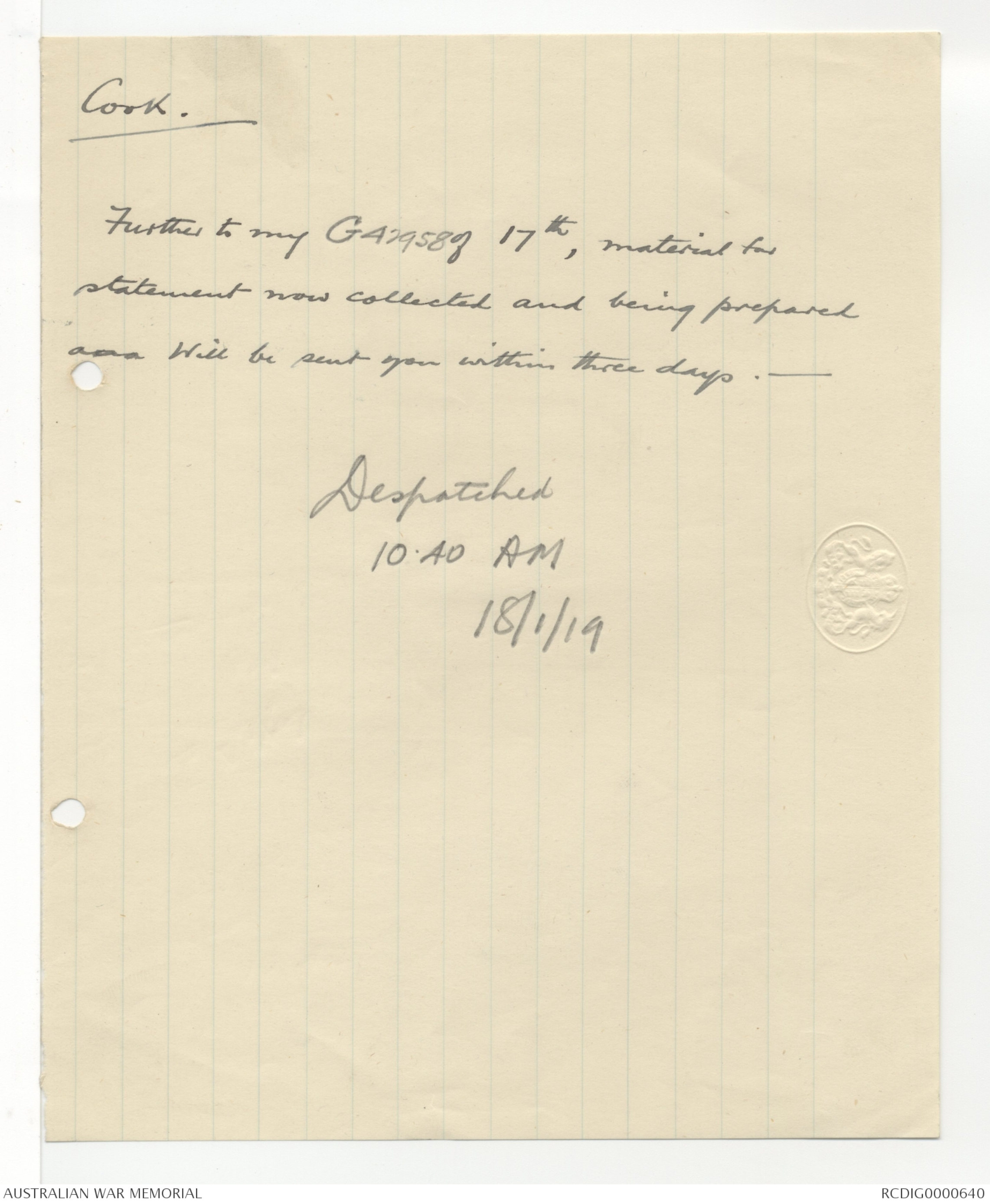
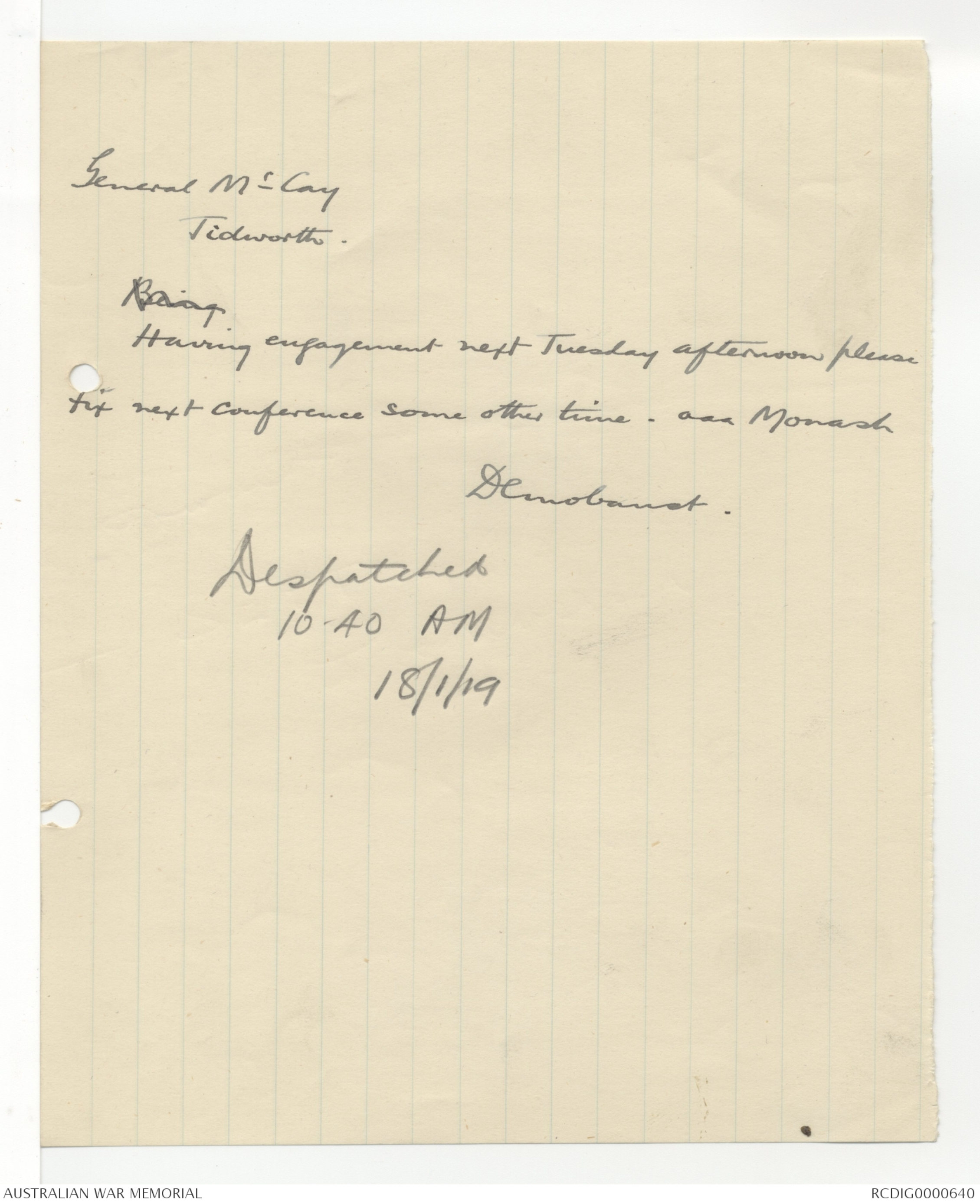
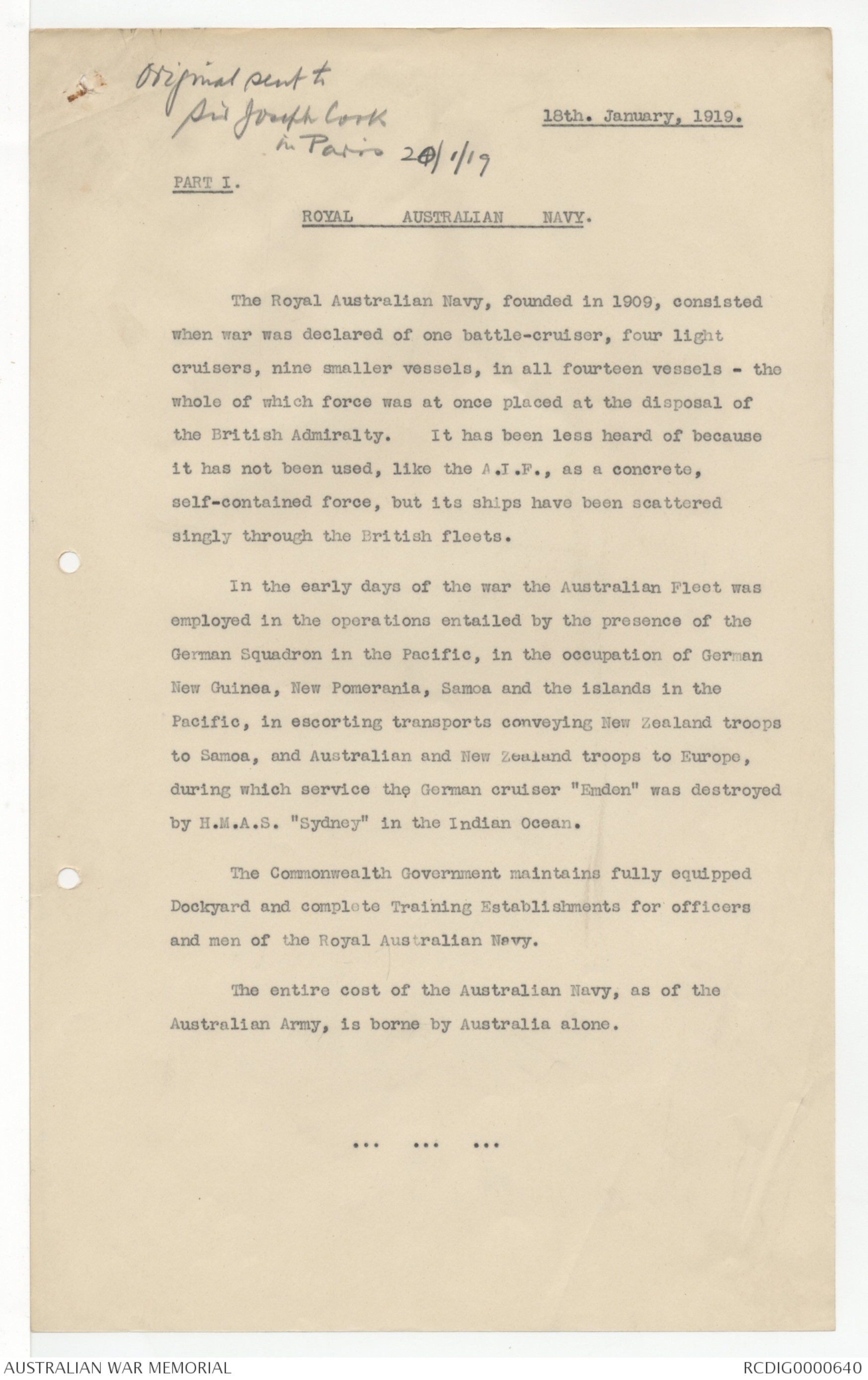
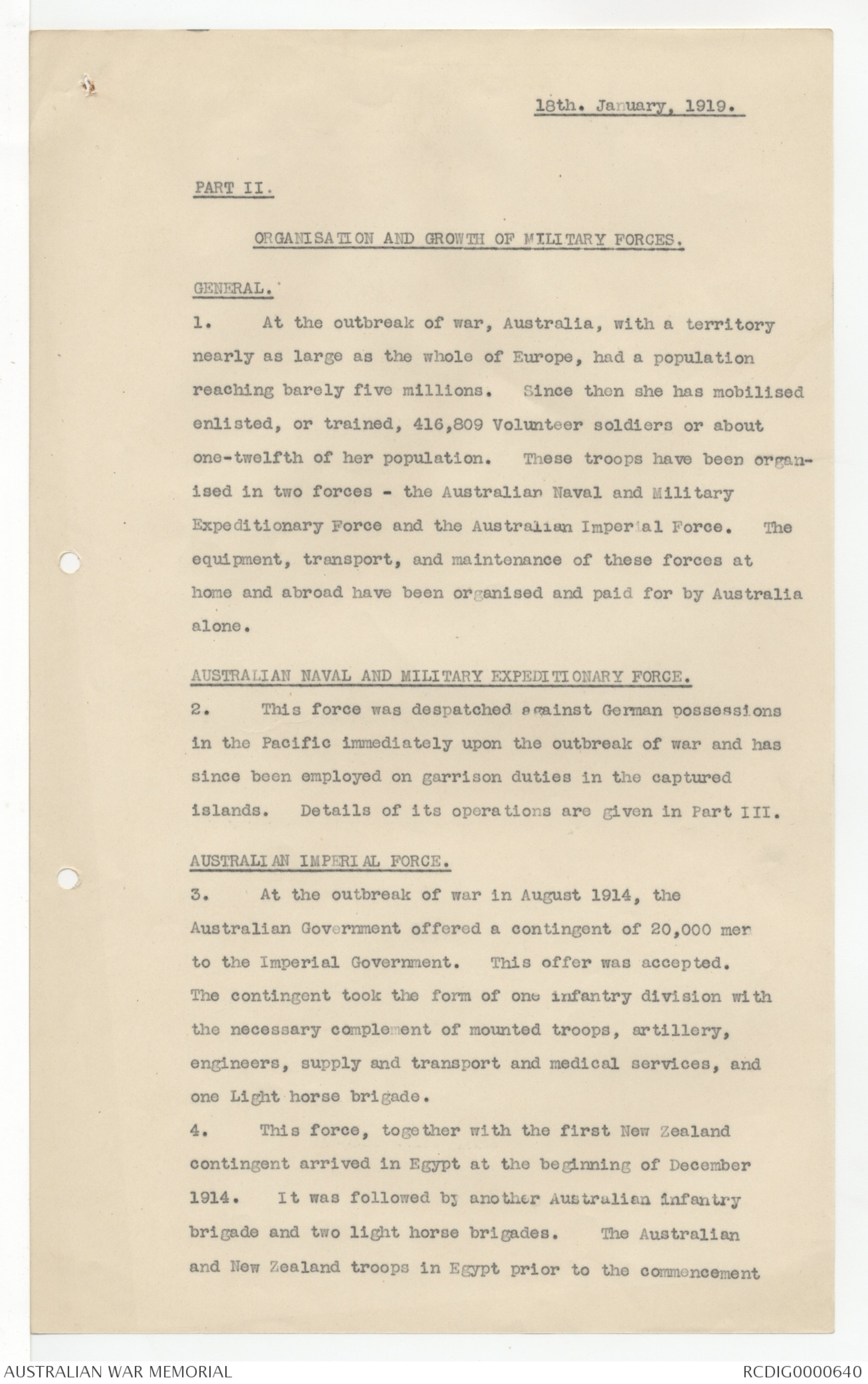
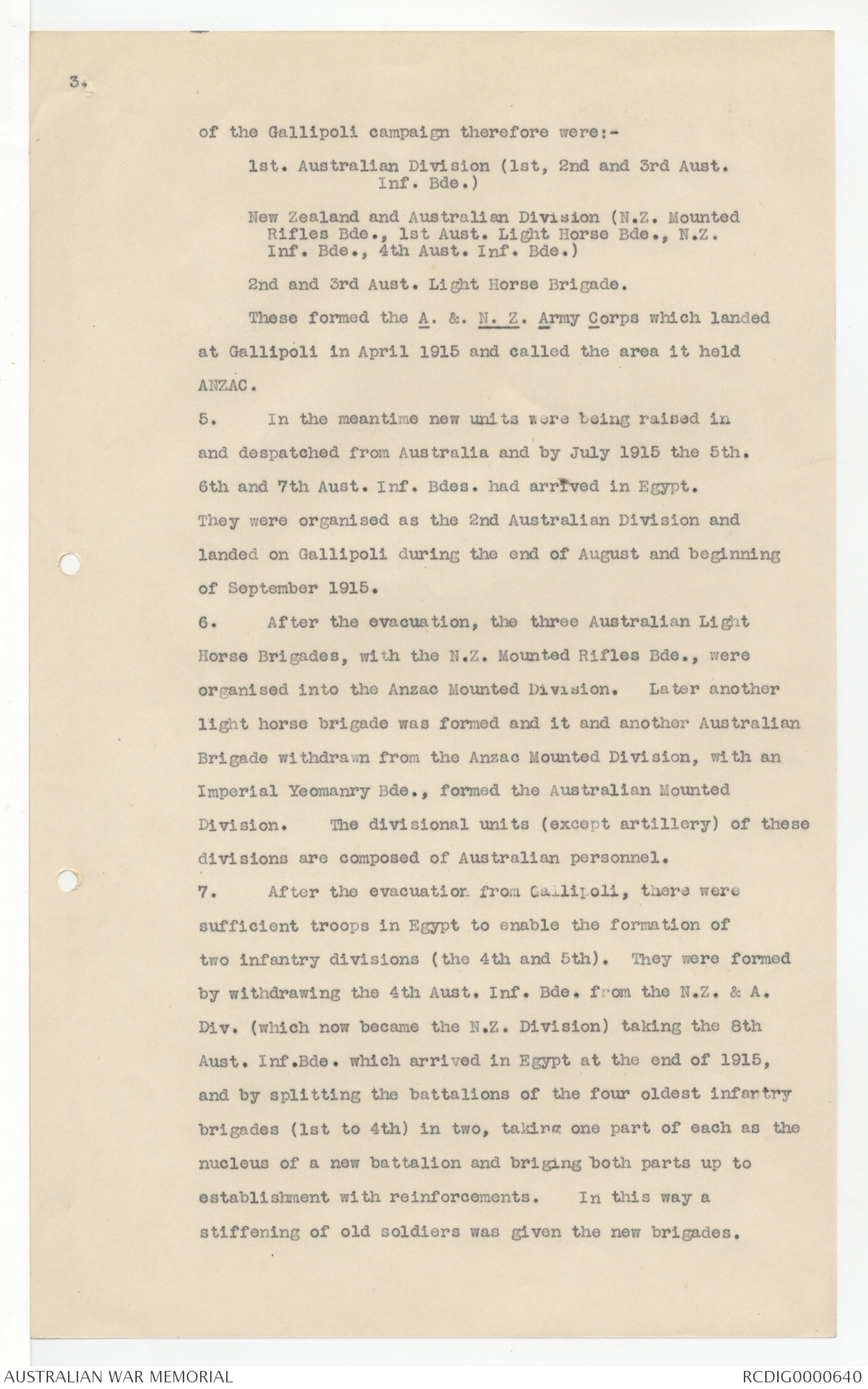
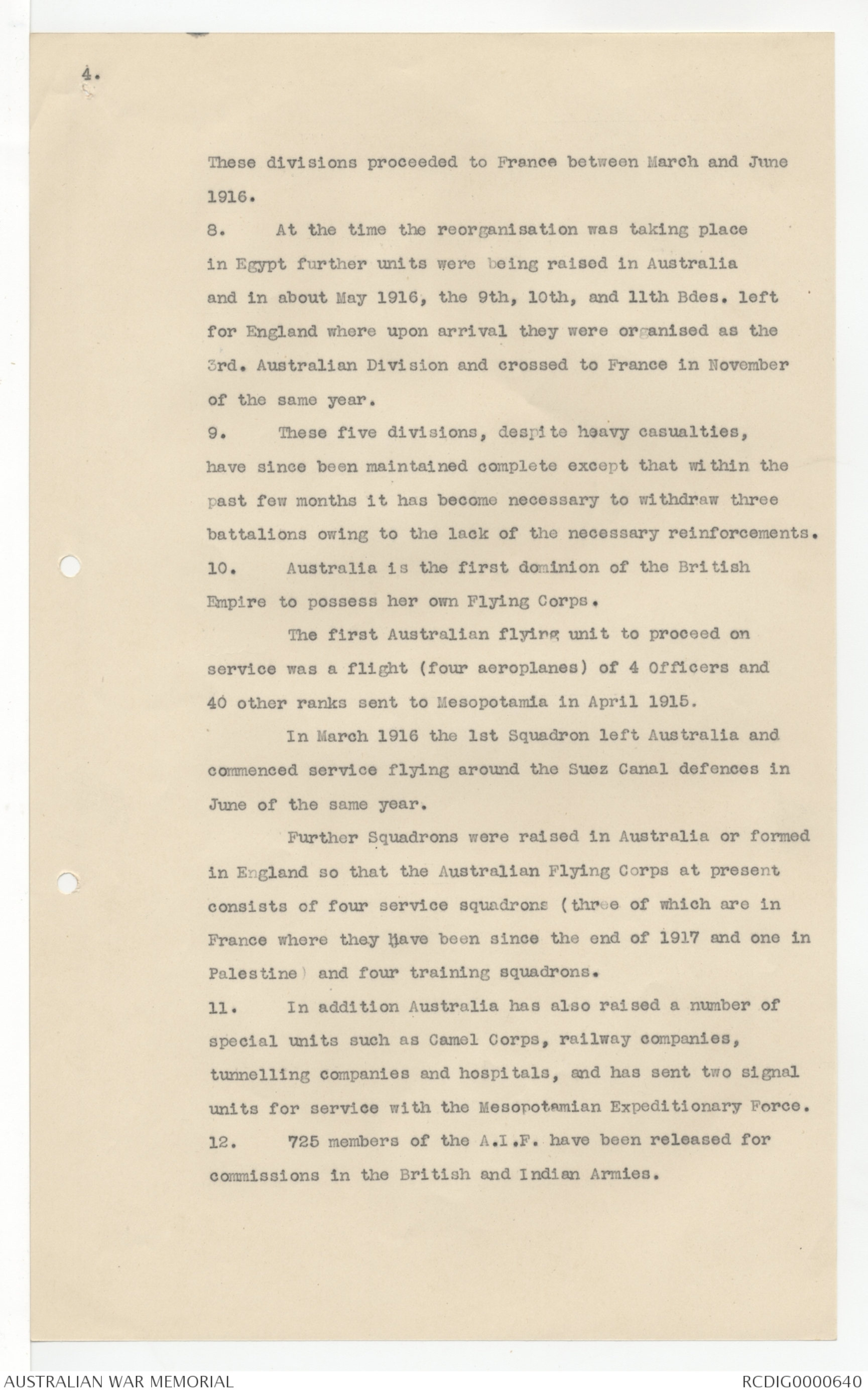
7. Nevertheless Australia is getting a very good share of the available
Ships, and the prospect is that we shall ^continue to get, on the average, aships every second day. - We have been doing this getting a ship every second day all December,
and January, & there is every reason to believe ^that we shall be able
to get ships at this rate throughout // 8. Remember that every ship
has to be entirely cleaned & refitted, so as to make her suitable to
carry troops ^on a long voyage in comfort. - This is an enormous job, when you
remember the great difficulties in procuring competent ^and sufficient labour
at this juncture in English ports.-
9. The pressure upon the railways, both in France & England,
is also very severe. There is a ^serious shortage of rolling stock, and
railroads are in bad repair.- Thus, blocks and delays are
continually occurring, with inevitable inconvenience and
discomfort to the troops.-
10. In spite of all these difficulties, we are succeeding in getting
our men home at an average rate of 500 a day. - Since
the beginning of December 1st last we have actually embarked well over 20,000.
Most of these were invalids; & noone will begrudge ^sick & wounded men them the
chance of getting home early.- He are now making a definite
start with the troops in France, and will steadily speed up to a
maximum ^average rate of 500 a day. Over 10,000 ten thousand men from France will
reach England before the end of
January for Embarkation to Australia. This is a very substantial beginning. -
11. The rule is ^going to be that ^those who have been longest in the A.I.F. will be
the first to go home. - This is fair to all. - These There are
over 35000 35000 men who enlisted in 1915 ^or before who must so home
before the turn comes for any men who enlisted in 1916. This
alone will take 70 days from the time we started on this batch.
Then ^there are 750,000 men of 1916 enlistment, 30000 of 1917 and
15000 of 1918. - So, at 500 a day, you can work out form some idea for
yourselves, how long you will have to wait before your turn
comes, - provided even if there is no unexpected breakdown at any
point in the long and intricate chain between your Unit and
the ship which will carry you home. -
12. In order to avoid any invidious distinctions, each Australian
Division will be given a ship, turn and turn about, in strict rotation
Thus, each Division will send away 1000 men every 10 or 12 days, &
Units not forming part of a Division will not be forgotten
13. Arrangements have also been made to discharge men in England
for satisfactory reasons; also to return ^men to Australia men early for sufficiently
urgent reasons; also to find educational or industrial employment
^with or in France or England for men whose turn to go home will come only later, ^and so on & we -all
these benefits are accompanied by liberal conditions of pay and
allowances.- If you want to know more about these matter,
ask your Officer, or the Education Officer of your Unit.
14.- It is a mistake to any man to imagine that, if he with applies for
any of these benefits, it will in some way delay his going home. This
is not the case.- No man's return will be delayed, without his own
consent, if he decides to accept a job in England, or to undergo some
course of training. - All he has to do is to say, when he applies, that he
is not agreeable to have his return delayed.
15.- We want men to apply freely tor employment of all kinds (including
training and education) because we want men to forget
the dangers and hardships of the war, and to renew their interest
in life and in their own futures. - We do this for the sake of the men
themselves, and for the sake of Australia.- We cannot do it at all,
unless the men come forward voluntarily and apply to be given
some congenial and interesting work in England, while waiting
for their ships, instead of having an idle and useless time in France
and Belgium.
16.- The success of the whole Demobilisation depends largely on
the good temper, the patience, the loyalty and the desire to play the
game of the men themselves. - Even such a small matter as a
few men going absent and missing delaying a train or a ship will
cause confusion and delay, not only to themselves, but to their mates
It is ^for this reason every man's business to discourage misconduct,^incorigibility in every tarn
17. The fighting efficiency and renown of the A.I.F. have been a model
for all other Armies in the field during the war- Let us all ^therefore give best to make
our Denobilization also a model for all other Countries, by the
smoothness and regularity with which we ^will carry it through
[* RDC Draft*]
Sir Joseph Cook,
PEACE CONFERENCE
HOTEL MATESTIC
Paris
I Have no statement regarding
Australian Land War Effort nos any
material accessible from which to prepare
same aaa Am referring your enquiry to
General White who now on London.
Monach.
Despatched 17/1/19
HAM
[*RD 17/1/19*]
[*42959*]
[* ADMINISTRATIVE HEADQUARTERS
A.I.F.
Central Registry*]
Austr. Corps.
In view mail delays if ^insufficient Demobilization Forms not available
typewrtten copies will be accepted pending arrival further supplieys
Printed forms aaa Wire us your requirements further forms aaaaAddressed Australian Corps, repeated all Divisions.
Demobaust.
Cook.
Further to my G42958 of 17th, material for
statement now collected and being prepared
and will be sent you within three days.
Despatched
10.40 AM
18/1/19
General McCay
TidworthBeing
Having engagement next Tuesday afternoon please
Fix next conference some other time aaa Monash
Demobaust.
Despatched
10-40 AM
18/1/9
[* Original sent to
Sir Joseph Cook
in Paris
240/1/19*]
18th. January, 1919.
PART I.
ROYAL AUSTRALIAN NAVY.
The Royal Australian Navy, founded in 1909, consisted
when war was declared of one battle-cruiser, four light
cruisers, nine smaller vessels, in all fourteen vessels - the
whole of which force was at once placed at the disposal of
the British Admiralty. It has been less heard of because
1t has not been used, like the A.I.F., as a concrete,
self-contained force, but its ships have been scattored
singly through the British fleets.
In the early days of the war the Australian Fleet was
employed in the operations entailed by the presence of the
German Squadron in the Pacific, in the occupation of German
New Guinea, New Pomerania, Samoa and the islands in the
Pacific, in escorting transports conveying New Zealand troops
to Samoa, and Australian and New Zealand troops to Europe,
during which service the German cruiser "Emden" was destroyed
by H.M.A.S. Sydney in the Indian Ocean.
The Commonwealth Government maintains fully equipped
Dockyard and complete Training Establishments for officers
and men of the Royal Australian Navy.
The entire cost of the Australian Navy, as of the
Australian Army, is borne by Australia alone.
2.
18th. January, 1919.
PART II.
ORGANISATION AND GROWTH OF MILLTARY FORCES.
GENERAL.
1. At the outbreak of war, Australia, with a territory
nearly as large as the whole of Europe, had a population
reaching barely five millions. Since then she has mobilised
enlisted, or trained, 416,809 Volunteer soldiers or about
one-twelfth of her population. These troops have been organised
in two forces - the Australian Naval and Military
Expeditionary Force and the Australian Imperial Force. The
equipment, transport, and maintenance of these forces at
home and abroad have been organised and paid for by Australia
alone.
AUSTRALIAN NAVAL AND MILITARY EXPEDITIONARY FORCE.
2. This force was despatched against German possessions
in the Pacific immediately upon the outbreak of war and has
since been employed on garrison duties in the captured
islands. Details of its operations are given in Part III.
AUSTRALIAN IMERIAL FORCE.
3. At the outbreak of war in August 1914, the
Australian Government offered a contingent of 20,000 men
to the Imperial Government. This offer was accepted.
The contingent took the form of one infantry division with
the necessary complement of mounted troops, artillery,
engineers, supply and transport and medical services, and
one Light horse brigade.
4. This force, together with the first New Zealand
contingent arrived in Egypt at the beginning of December
1914. 1t was followed by another Australian Infantry
brigade and two light horse brigades. The Australian
and New Zealand troops in Egypt prior to the commencement
3.
of the Gallipoli campaign therefore were:-
1st. Australian Division (1st, 2nd and 3rd Aust.
Inf. Bde.)
New Zealand and Australian Division (N.Z. Mounted
Rifles Bde., 1st Aust. Light Horse Bde., N.Z.
Inf. Bde., 4th Aust. Inf. Bde.)
2nd and 3rd Aust. Light Horse Brigade.
These formed the A. &. N. Z. Army Corps which landed
at Gallipoli in April 1915 and called the area it held
ANZAC.
5. In the meantime new units wore being raised in
and despatched from Australia and by July 1915 the 5th.
6th and 7th Aust. Inf. Bdes. had arrrved in Egypt.
They were organised as the 2nd Australian Division and
landed on Gallipoli during the end of August and beginning
of September 1915.
6. After the evacuation, the three Australian Light
Horse Brigades, with the N.Z. Mounted Rifles Bde., were
organised into the Anzac Mounted Division. Later another
light horse brigade was formed and it and another Australian
Brigade withdrawn from the Anzac Mounted Division, with an
Imperial Yeomanry Bde., formed the Australian Mounted
Division. The divisional units (except artillery) of these
divisions are composed of Australian personnel.
7. After the evacuation from Gallipoli, there were
sufficient troops in Egypt to enable the formation of
two infantry divisions (the 4th and 5th). They were formed
by withdrawing the 4th Aust. Inf. Bde. from the N.Z. & A.
Div. (which now became the N.Z. Division) taking the 8th
Aust. Inf.Bde. which arrived in Egypt at the end of 1915,
and by splitting the battalions of the four oldest infantry
brigades (1st to 4th) in two, taking one part of each as the
nucleus of a new battalion and briging both parts up to
establishment with reinforcements. In this way a
stiffening of old soldiers was given the new brigades.
4.
These divisions proceeded to France between March and June
1916.
8. At the time the reorganisation was taking place
in Egypt further units were being raised in Australia
and in about May 1916, the 9th, 10th, and 11th Bdes. left
for England where upon arrival they were organised as the
3rd. Australian Division and crossed to France in November
of the same year.
9. These five divisions, despite heavy casualties,
have since been maintained complete except that within the
past few months it has become necessary to withdraw three
battalions owing to the lack of the necessary reinforcements.
10. Australia is the first dominion of the British
Empire to possess her own Flying Corps.
The first Australian flying unit to proceed on
service was a flight (four acroplanes) of 4 Officers and
40 other ranks sent to Mesopotamia in April 1915.
In March 1916 the 1st Squadron left Australia and
commenced service flying around the Suez Canal defences in
June of the same year.
Further Squadrons were raised in Australia or formed
in England so that the Australian Flying Corps at present
consists of four service squadrons (three of which are in
France where they have been since the end of 1917 and one in
Palestine) and four training squadrons.
11. In addition Australia has also raised a number of
special units such as Camel Corps, railway companies,
tunnelling companies and hospitals, and has sent two signal
units for service with the Mesopotamian Expeditionary Force.
12. 725 members of the A.I.F. have been released for
commissions in the British and Indian Armies.
 Sam scott
Sam scottThis transcription item is now locked to you for editing. To release the lock either Save your changes or Cancel.
This lock will be automatically released after 60 minutes of inactivity.